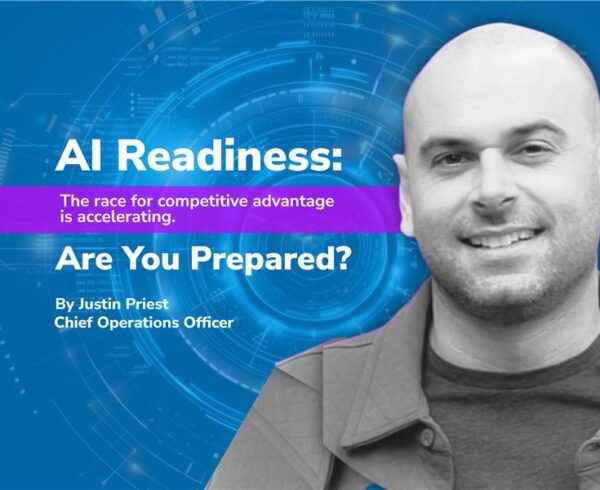Everyone wants generative AI, but most organizations can’t even access the right data.
I’ve recently spoken with CIOs, CTOs, and CDOs across industries who are under pressure to “do something” with AI. The appetite for pilots and platform investments is sky-high, but the same roadblock keeps appearing when it’s time to feed the models. The data isn’t ready. It’s scattered across silos, inconsistent in format, missing key fields, or owned by teams who can’t even agree on definitions.
And that’s not a minor detail. AI is only as good as the data it learns from. Without the right data architecture, governance, and quality controls in place, even the most advanced AI platforms will generate unreliable, biased, or incomplete outputs. Gartner warns that in the coming years, 60% of AI projects will fail because of insufficient data readiness. For many organizations, the real barrier to AI value isn’t a technology gap—it’s a data strategy gap.
WHY DATA READINESS MATTERS MORE THAN THE MODEL
The industry loves to talk about algorithms and vendors, but the real differentiator is the data behind them. If that data is incomplete, inaccurate, or inaccessible, AI underperforms and can create risk at scale.
For instance, KPMG’s analysis reveals that AI and ML initiatives are 83% more likely to achieve their intended outcomes when built upon robust data governance foundations.
These organizations have created environments where data is easy to find, consistent in format, and trusted by the teams who rely on it. Accessible data means engineers and analysts can locate the information they need without navigating multiple silos. Accurate data is free of errors, duplicates, and outdated records. Aligned data is standardized across the business so every team works from the same source of truth.
Without these elements, AI initiatives often stumble into one of three traps:
1. FALSE CONFIDENCE – AI produces outputs that look convincing but are factually wrong due to flawed inputs.
2. OPERATIONAL FRICTION – Teams spend more time cleaning and reconciling data than building AI solutions.
3. COMPLIANCE RISK – Sensitive data is misused or exposed due to unclear governance.
By contrast, companies without that foundation spend more time fixing data issues than building AI solutions. This often means models are trained on flawed inputs, creating a “garbage in, garbage out” scenario that erodes both trust and momentum.
WHAT HAPPENS WHEN YOU RUSH
I’ve seen too many organizations skip the groundwork in the race to deploy AI, only to pay for it later. One global retailer launched a recommendation engine without consolidating and cleaning its product and customer data. The results were predictable: irrelevant suggestions, mismatched pricing, and promotions for out-of-stock items. The system had to be paused, the data pipelines rebuilt, and the overall cost nearly doubled.
On the other hand, a manufacturing leader took the opposite approach. They delayed rollout by six months to unify operational, sensor, and maintenance records into a single, curated data lake. When the AI went live, predictive maintenance alerts hit over 90% accuracy, downtime dropped, and ROI was visible in the first quarter. The lesson? The delay wasn’t a setback; it was the single biggest reason for their success.
When IT leaders move forward without addressing data readiness, familiar problems surface. Data silos restrict the scope of AI because Marketing owns one dataset, Operations manages another, and Finance maintains its own definitions. In this environment, AI produces fragmented insights. Integration is further derailed by inconsistent formats: “Customer” might mean one thing in the CRM, another in the ERP, and something else entirely in the data warehouse. Without extensive preprocessing, models can’t reconcile these differences. Governance often gets dismissed as red tape, but without clear ownership and quality standards, datasets degrade and AI results drift over time.
The result? Delayed projects, inflated budgets, and leadership teams losing confidence in AI as a business driver.
LAYING THE GROUNDWORK FOR AI
Getting data ready for AI isn’t about a one-time cleanup, it’s about building systems and processes that maintain quality over time. The work starts with a comprehensive data quality assessment, measuring completeness, accuracy, timeliness, and consistency across key domains. The goal isn’t perfection but identifying the most critical gaps and addressing them first.
If you’re building an AI strategy today, these are the foundational steps we advise before investing heavily in models and integrations:
| Steps | Action Items |
| Run a comprehensive data quality assessment |
|
| Integrate and unify data across silos |
|
| Establish governance frameworks |
|
| Secure and democratize access |
|
| Embed continuous monitoring |
|
AVOIDING THE COMMON PITFALLS
Organizations that struggle with AI adoption often face the same issues: silos that limit AI’s scope and force manual workarounds, inconsistent definitions for core entities across systems, and governance gaps that leave no one accountable when quality slips. These aren’t minor inconveniences—they’re barriers that can stop AI initiatives entirely and erode trust in the technology. Once a business user receives a flawed AI-driven recommendation, regaining their confidence can take longer than fixing the data itself.
WHY IT’S WORTH THE EFFORT
The payoff for getting this right is significant. Deloitte found that companies with high-quality, well-governed data are twice as likely to achieve their AI objectives compared to those without. In practical terms, this means AI pilots get launched faster, adoption scales across more functions, and the business can innovate without being held back by data bottlenecks.
We’ve seen data-first organizations:
-
- Launch AI pilots in weeks instead of months.
-
- Expand AI into multiple functions without re-engineering pipelines.
-
- Maintain trust in AI outputs because stakeholders know where the data came from and how it’s governed.
When data is AI-ready, IT leaders can focus on building models, integrating outputs into workflows, and measuring real business impact instead of firefighting integration and quality issues. This is where AI moves from proof-of-concept to a true driver of competitive advantage.
THE STRATEGIC IMPERATIVE
Generative AI will amplify whatever you feed it whether it’s good or bad. If your data is fragmented or outdated, it will scale those flaws across the enterprise. If it’s clean, unified, and governed, AI can deliver insights and automation you can actually trust.
For IT leaders, the smartest move isn’t chasing the latest AI tool—it’s building the data strategy that makes AI worth running. That starts with owning your data, not just storing it. The sooner you invest in that foundation, the faster your AI initiatives will deliver measurable, lasting value.






